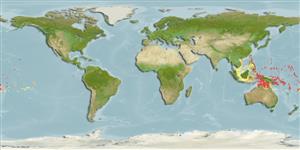Common names from other countries
Klassifizierung / Names
Namen | Synonyme | Catalog of Fishes(Gattung, Arten) | ITIS | CoL | WoRMS | Cloffa
>
Eupercaria/misc (Various families in series Eupercaria) >
Labridae (Wrasses) > Xyrichtyinae
Etymology: Novaculops: Latin, novacula = razor + Greek, ops = appearance (Ref. 45335); halsteadi: Named for Robert A. Halstead, who observed the species in Papua New Guinea and suspected it was undescribed..
More on authors: Randall & Lobel.
Environment: milieu / climate zone / depth range / distribution range
Ökologie
seewasser riff-verbunden; tiefenbereich 15 - 100 m (Ref. 90102). Tropical
Pacific: Papua New Guinea, Guam, Wake Island, and Tahiti.
Size / Gewicht / Alter
Maturity: Lm ? range ? - ? cm
Max length : 12.0 cm SL Männchen/unbestimmt; (Ref. 75958)
Kurzbeschreibung
Morphologie | Morphometrie
Rückenflossenstacheln (insgesamt): 9; Rückenflossenweichstrahlen (insgesamt): 12; Afterflossenstacheln 3; Afterflossenweichstrahlen: 12; Wirbelzahl: 25. This species is characterized by the following: D IX,12, the first two dorsal spines flexible and shorter than longest dorsal soft rays; body depth 3.1-3.35 in SL; cheek scaleless; 2 small scales dorsally on opercle; gill rakers 17-20; juveniles and females whitish with a red stripe from above eye to back at base of dorsal fin; males with a pale-edged black spot on seventh lateral-line scale and scales below (Ref. 75958).
Found solitary or in small groups near reefs in sand-rubble bottoms (Ref. 90102). Feeds on small benthic invertebrates (Ref. 89972). Maximum depth reported taken from Ref. 128797.
Life cycle and mating behavior
Geschlechtsreife | Fortpflanzung | Ablaichen | Eier | Fecundity | Larven
Oviparous, distinct pairing during breeding (Ref. 205).
Randall, J.E., 2013. Seven new species of labrid fishes (Coris, Iniistius, Macropharyngodon, Novaculops, and Pteragogus) from the Western Indian Ocean. J. Ocean Sci. Found. 7:1-43. (Ref. 93522)
IUCN Rote Liste Status (Ref. 130435)
CITES (Ref. 128078)
Not Evaluated
Bedrohung für Menschen
Harmless
Nutzung durch Menschen
Mehr Information
Alter/GrößeWachstumLänge-GewichtLänge-LängeLängenhäufigkeitenMorphometrieMorphologieLarvenLarven Pop.Dyn.RekrutierungDichte
ReferenzenAquakulturAquakultur ProfilZuchtlinienGenetikElectrophoresesVererbbarkeitKrankheitenVerarbeitungMass conversion
PartnerBilderStamps, Coins Misc.LauteCiguateraGeschwindigkeitSchwimmstilKiemenoberflächeOtolithsGehirngrößeSehfähigkeit
Tools
Zusatzinformationen
Download XML
Internet Quellen
Estimates based on models
Preferred temperature (Ref.
115969): 26.5 - 28.8, mean 27.9 (based on 72 cells).
Phylogenetic diversity index (Ref.
82804): PD
50 = 0.5156 [Uniqueness, from 0.5 = low to 2.0 = high].
Bayesian length-weight: a=0.01023 (0.00397 - 0.02640), b=3.06 (2.84 - 3.28), in cm Total Length, based on LWR estimates for this (Sub)family-body shape (Ref.
93245).
Trophic level (Ref.
69278): 3.4 ±0.4 se; based on size and trophs of closest relatives
Widerstandsfähigkeit (Ref.
120179): hoch, Verdopplung der Population dauert weniger als 15 Monate. (Preliminary K or Fecundity.).
Fishing Vulnerability (Ref.
59153): Low vulnerability (10 of 100).
